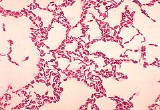
Bacillus coagulans
Overview
Bacillus coagulans is a lactic acid
-forming bacterial species within the genus Bacillus
. The organism was first isolated and described in 1932 and was elaborated in the fifth edition of Bergey's Manual of Determinative Bacteriology
. It was initially considered to be a spore-forming Lactobacillus
. Since Bacillus coagulans exhibits characteristics typical of both genera Lactobacillus and Bacillus, its taxonomic position between the families Lactobacillaceae and Bacillaceae was often debated.
Lactic acid
Lactic acid, also known as milk acid, is a chemical compound that plays a role in various biochemical processes and was first isolated in 1780 by the Swedish chemist Carl Wilhelm Scheele. Lactic acid is a carboxylic acid with the chemical formula C3H6O3...
-forming bacterial species within the genus Bacillus
Bacillus
Bacillus is a genus of Gram-positive, rod-shaped bacteria and a member of the division Firmicutes. Bacillus species can be obligate aerobes or facultative anaerobes, and test positive for the enzyme catalase. Ubiquitous in nature, Bacillus includes both free-living and pathogenic species...
. The organism was first isolated and described in 1932 and was elaborated in the fifth edition of Bergey's Manual of Determinative Bacteriology
Bergey's Manual of Determinative Bacteriology
The Bergey’s Manual of Systematic Bacteriology is the main resource for determining the identity of bacteria species, utilizing every characterizing aspect....
. It was initially considered to be a spore-forming Lactobacillus
Lactobacillus
Lactobacillus is a genus of Gram-positive facultative anaerobic or microaerophilic rod-shaped bacteria. They are a major part of the lactic acid bacteria group, named as such because most of its members convert lactose and other sugars to lactic acid. They are common and usually benign...
. Since Bacillus coagulans exhibits characteristics typical of both genera Lactobacillus and Bacillus, its taxonomic position between the families Lactobacillaceae and Bacillaceae was often debated.

